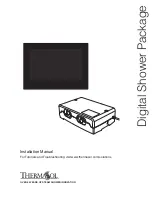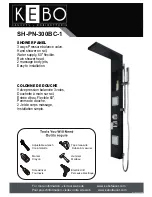
5
Upon receipt, the shipping carton must be immediately examined for damage. Any damage should be noted on the
delivery receipt and a request for inspection by the transportation company should be made. Next, the shipping
carton should be opened, and the chair must be examined for concealed shipping damage. If the chair appears to be
damaged, do not use the chair. File a concealed damage report with the transportation company.
2.4
Pre-Service Check
Broda chairs are delivered fully assembled. If the chair does not appear to be ready to use upon receipt, immediately
contact your supplier and do not put the chair into service until any concerns have been resolved.
Visually inspect the chair for damage, missing parts, and loose fasteners prior to testing the chair’s functions.
Functional testing must be successfully completed after visual inspection and before use. These obligations apply to
the chair’s first use and to all subsequent uses (Section 4: Inspection and Functional Testing).
2.5
Hazards
2.5.1
Position of Chair - “Danger of Falling”
After a resident is transferred into a chair, assess the amount of tilt required. We recommend that the chair’s seat be
tilted sufficiently to prevent the resident from sliding or falling forward off the chair. The amount of seat tilt used
should be determined by the resident’s caregiver who is responsible for seating.
We recommend that the resident’s feet be correctly positioned on the footrests and slightly to fully elevated to
prevent the resident from sliding or falling forward off the chair. The amount of elevation used should be determined
by the resident’s caregiver who is responsible for seating.
2.5.2
Position of Seat Tilt - “Danger of Tipping”
We recommend that the chair’s seat be tilted sufficiently to prevent an agitated resident from tipping the chair
forward or backward, or from slumping and sliding in the chair. The amount of seat tilt used should be determined
by the resident’s caregiver who is responsible for seating. Always ensure that the resident is properly positioned
before operating the seat tilt.
2.5.3
Location of Chair - “Danger of Tipping or Falling Objects”
We recommend that when a resident has been moved to their destination, the chair is placed where the resident
cannot reach handrails or other objects, fixed or movable. This is to prevent the resident from pulling the chair over
or pulling themselves off the seating surface and to prevent the resident from pulling movable objects onto the chair
and themselves.
We recommend that the chair be used in a supervised area to prevent untrained residents, caregivers, or third parties
from unauthorized operation, movement, or unsafe actions such as sitting or leaning on the reclined back, elevated
footrest, or the armrests. These actions, if not prevented, put the chair at risk of tipping or damage to the chair.
We recommend that a chair only be located on a level surface to minimize the risk of tipping over.
2.5.4
Total Lock Wheel Brakes - “Danger of Falling”
The special casters found on the Broda chair have total lock brakes which prevent the wheels from turning and
swiveling. The brakes must always be applied when:
1)
the chair is not in use
2)
the chair is not being moved by the caregiver
3)
a resident is being transferred (moved) into or out of the chair;
It is important to note that if the wheel locks are applied while the patient is in the chair, that the caregiver does not
leave the patient unattended, especially those patients who have the capability or tendency to move the chair and/or
those who may be agitated. This could cause harm to the patient if they attempt to move the chair while the wheel
locks are applied.
Note that removing and attaching the footrest may be easier for the caregiver with the brakes applied








































